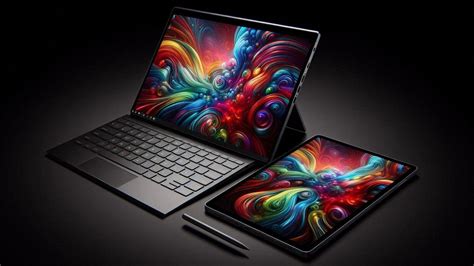In the realm of computing, the line between laptops and tablets has blurred over time, giving rise to versatile 2-in-1 devices that seamlessly combine the functionality of both worlds. These hybrid machines offer a unique proposition, blending the portability and touch-based interface of tablets with the productivity and keyboard comfort of laptops. However, understanding the intricacies of their engineering requires a comprehensive exploration of the technical differences that distinguish 2-in-1 laptops from tablets.

Form Factor and Hinge Design
One of the primary differentiating factors between 2-in-1 laptops and tablets lies in their form factor and hinge design. Laptops typically feature a clamshell design with a rigid hinge, allowing the screen to be positioned at a fixed angle relative to the keyboard. Tablets, on the other hand, adopt a more streamlined approach, with the screen and base connected by a flexible hinge that enables a wider range of orientations. This versatility allows tablets to be used in both laptop and tablet modes, providing greater adaptability for various use cases.
Processor and Performance
The performance capabilities of 2-in-1 laptops and tablets largely depend on the processor they incorporate. Laptops tend to feature more powerful processors, such as Intel Core i5 or i7 chips, which offer enhanced computing power for demanding tasks like video editing, gaming, or multitasking. Tablets, on the other hand, often incorporate ARM-based processors, which prioritize energy efficiency and affordability, making them suitable for basic browsing, video streaming, and content consumption.
Storage and Memory
Storage capacity and memory play a crucial role in the overall performance and functionality of 2-in-1 devices. Laptops generally offer higher storage capacities, ranging from 256GB to 1TB, providing ample space for storing files, programs, and media. Tablets, in contrast, typically have lower storage capacities, with most models offering between 128GB and 256GB. However, some high-end tablets may offer expandable storage options via microSD cards.
Battery Life and Connectivity
Battery life is a critical consideration for both laptops and tablets. Laptops, with their larger batteries and optimized power management, typically offer longer battery life, ranging from 8 to 12 hours or more. Tablets, on the other hand, prioritize portability and compactness, which often comes at the expense of battery life. Most tablets offer between 6 to 10 hours of battery life, depending on usage patterns.
Operating System and Software
2-in-1 devices can run various operating systems, including Windows, macOS, Chrome OS, and Android. Windows 10 is the most common operating system for 2-in-1 laptops, offering a wide range of applications, software, and hardware compatibility. Tablets, on the other hand, primarily run on Android or iOS, which are designed for touch-based interfaces and mobile-centric applications.
Input and Output Devices
2-in-1 laptops and tablets differ in terms of input and output devices. Laptops typically feature a physical keyboard that provides tactile feedback and faster typing speeds, while tablets rely on virtual keyboards, which offer portability and space optimization. Tablets often lack dedicated ports for peripherals, while laptops commonly include USB ports, HDMI ports, and other connectivity options.
Price and Value
The price of 2-in-1 devices varies depending on their specifications and features. Premium 2-in-1 laptops with powerful processors, high-resolution displays, and ample storage can be priced between $1,000 to $2,000 or more. Tablets, on the other hand, are generally more affordable, with entry-level models starting at around $200 to $300 and mid-range models ranging between $500 to $800.
Applications and Use Cases
2-in-1 devices offer versatility across various use cases. Laptops are ideal for tasks that require productivity, multitasking, or extended computing sessions, such as writing, coding, or graphic design. Tablets, with their portability and touch-based interfaces, excel in tasks such as content consumption, browsing, gaming, and note-taking. The hybrid nature of 2-in-1 devices allows for a wider range of applications, including digital art, presentations, and educational activities.
Advantages and Disadvantages
Advantages of 2-in-1 Laptops:
- Powerful performance for demanding tasks
- Larger storage capacities
- Longer battery life
- Physical keyboard for faster typing
- Wider range of connectivity options
Advantages of Tablets:
- Portability and compactness
- Touch-based interfaces for intuitive navigation
- Lower price points
- Energy-efficient operation
Disadvantages of 2-in-1 Laptops:
- Can be bulkier and heavier than tablets
- Physical keyboard may limit mobility
- More expensive than tablets
Disadvantages of Tablets:
- Limited performance for complex tasks
- Lower storage capacities
- Shorter battery life
- Virtual keyboards may be less efficient for typing
- Fewer connectivity options
Tips and Tricks for Choosing the Right Device
When choosing between a 2-in-1 laptop and a tablet, it is essential to consider your specific needs and preferences. Ask yourself the following questions:
- What is the primary purpose of the device?
- What level of performance do I require?
- How important is portability to me?
- What type of operating system do I prefer?
- What is my budget?
By answering these questions, you can narrow down your options and make an informed decision.
Future Applications and Innovation
The convergence of laptops and tablets is expected to continue in the future, leading to even more innovative and versatile 2-in-1 devices. Here are a few potential applications:
- Foldable Devices: Devices with flexible screens that can be folded or rolled up, providing a compact form factor and the ability to switch seamlessly between laptop and tablet modes.
- Dual-Screen Devices: Devices with two screens, allowing for multitasking, extended workspace, and enhanced gaming experiences.
- Augmented Reality Integration: Devices that incorporate augmented reality technology, providing immersive experiences for gaming, education, and business applications.
As technology advances, we can expect 2-in-1 devices to become even more prevalent and transformative, blurring the lines between traditional computing categories and empowering users with unprecedented flexibility and functionality.
